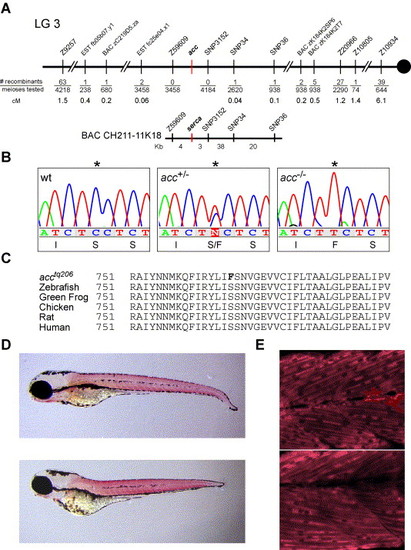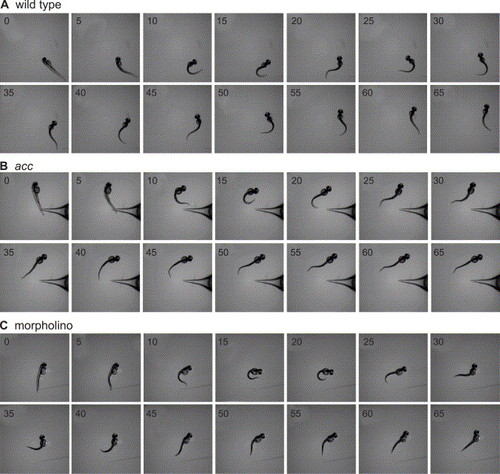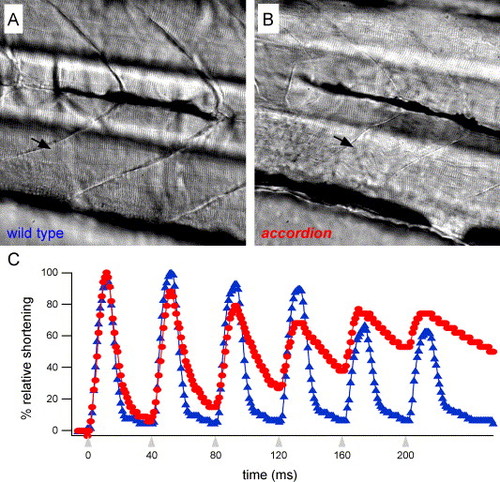- Title
-
A mutation in serca underlies motility dysfunction in accordion zebrafish
- Authors
- Gleason, M.R., Armisen, R., Verdecia, M.A., Sirotkin, H., Brehm, P., and Mandel, G.
- Source
- Full text @ Dev. Biol.
|
Positional cloning of the acc gene. (A) Genetic (circle denotes centromeric end) and partial physical maps of the LG3 region containing the acc locus. EST fc25e04.x1 (2 recombinants/3458 meioses) and SNP34 (1 recombinant/2620 meioses) flank the critical interval. On BAC clone CH211-11K18, zero recombinant markers Z59609 and SNP3152 reside 4 and 3 kb, respectively, from serca. The relative distances between markers on the physical map correspond to the genetic map, and therefore are not scaled. (B) DNA sequence analysis of zebrafish serca cDNA reveals a C to T transition at position 2297 (denoted by asterisks in the partial chromatographs shown). The possession of both acc and wild type alleles in heterozygous fish is reflected in the existence of two overlapping peaks at this position. (C) The mutation predicts the substitution of a serine to a phenylalanine (in bold) at residue 766. Alignment of the protein sequences of SERCA in zebrafish, frog, chicken, rat, and human indicates that the mutation occurs in a highly conserved region (100% identity in the stretch of 40 amino acids shown). (D, E) Whole-mount in situ hybridization using antisense serca riboprobes. (D) Lateral view of stained wild type (top) and acc (bottom) fish at 4 days. (E) serca expression in fast skeletal muscle fibers in the tail of a 5-day wild type (top) and acc (bottom) fish, using confocal microscopy. Lateral view of a few segments of the tail. Anterior is left. Dorsal is top. |
|
Touch-mediated escape responses in 2-day-old fish. The escape response was elicited by a gentle prod to the tail with the tip of a glass electrode, as shown in B. Individual frames, taken at 5-ms intervals, are shown for (A) wild type, (B) homozygous acc and (C) morpholino-injected wild type fish. The 512 × 512 pixel images were collected with a FASTCAM 512 PCI (Photron USA) at a sampling rate of 1000 frames per second. |
|
Muscle shortening in acc and wild type fish. Lateral view of a few segments in the intact tail of (A) wild type and (B) acc fish. Top is dorsal. Arrows point to individual muscle cells. (C) Muscle displacement over time in the intact tail of a 9-day wild type (blue, triangles) and acc (red, circles) fish in response to a train of six 1-ms current pulses applied to muscle. High-speed images of stimulus-induced muscle contraction and relaxation were taken every 1 ms. From these images, measurements of muscle displacement were made by tracking, frame by frame, the movement of a single point on an individual muscle cell, using Photron Motion Tools software. The magnitude of the response was then normalized to the maximum displacement observed and plotted as a function of time. Arrowheads indicate the time of stimulation. |
Reprinted from Developmental Biology, 276(2), Gleason, M.R., Armisen, R., Verdecia, M.A., Sirotkin, H., Brehm, P., and Mandel, G., A mutation in serca underlies motility dysfunction in accordion zebrafish, 441-451, Copyright (2004) with permission from Elsevier. Full text @ Dev. Biol.



